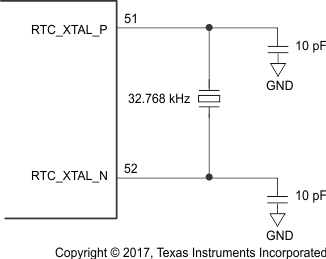SWRS215E April 2019 – December 2024 CC3235S , CC3235SF
PRODUCTION DATA
- 1
- 1 Features
- 2 Applications
- 3 Description
- 4 Functional Block Diagrams
- 5 Device Comparison
- 6 Pin Configuration and Functions
-
7 Specifications
- 7.1 Absolute Maximum Ratings
- 7.2 ESD Ratings
- 7.3 Power-On Hours (POH)
- 7.4 Recommended Operating Conditions
- 7.5 Current Consumption Summary (CC3235S)
- 7.6 Current Consumption Summary (CC3235SF)
- 7.7 TX Power Control for 2.4 GHz Band
- 7.8 TX Power Control for 5 GHz
- 7.9 Brownout and Blackout Conditions
- 7.10 Electrical Characteristics for GPIO Pins
- 7.11 Electrical Characteristics for Pin Internal Pullup and Pulldown
- 7.12 WLAN Receiver Characteristics
- 7.13 WLAN Transmitter Characteristics
- 7.14 WLAN Transmitter Out-of-Band Emissions
- 7.15 BLE/2.4 GHz Radio Coexistence and WLAN Coexistence Requirements
- 7.16 Thermal Resistance Characteristics for RGK Package
- 7.17
Timing and Switching Characteristics
- 7.17.1 Power Supply Sequencing
- 7.17.2 Device Reset
- 7.17.3 Reset Timing
- 7.17.4 Wakeup From HIBERNATE Mode
- 7.17.5 Clock Specifications
- 7.17.6 Peripherals Timing
- 8 Detailed Description
- 9 Applications, Implementation, and Layout
- 10Device and Documentation Support
- 11Revision History
- 12Mechanical, Packaging, and Orderable Information
Package Options
Mechanical Data (Package|Pins)
- RGK|64
Thermal pad, mechanical data (Package|Pins)
- RGK|64
Orderable Information
7.17.5.1 Slow Clock Using Internal Oscillator
The RTC crystal connected to the device supplies the free-running slow clock. The accuracy of the slow clock frequency must be 32.768kHz ±150ppm. In this mode of operation, the crystal is tied between RTC_XTAL_P (pin 51) and RTC_XTAL_N (pin 52) with a suitable load capacitance to meet the ppm requirement.
Figure 7-9 shows the crystal connections for the slow clock.
 Figure 7-9 RTC Crystal Connections
Figure 7-9 RTC Crystal Connections
Table 7-18 lists the RTC crystal requirements.
Table 7-18 RTC Crystal Requirements
| CHARACTERISTICS | TEST CONDITIONS | MIN | TYP | MAX | UNIT |
|---|---|---|---|---|---|
| Frequency | 32.768 | kHz | |||
| Frequency accuracy | Initial plus temperature plus aging | ±150 | ppm | ||
| Crystal ESR | 32.768kHz | 70 | kΩ |